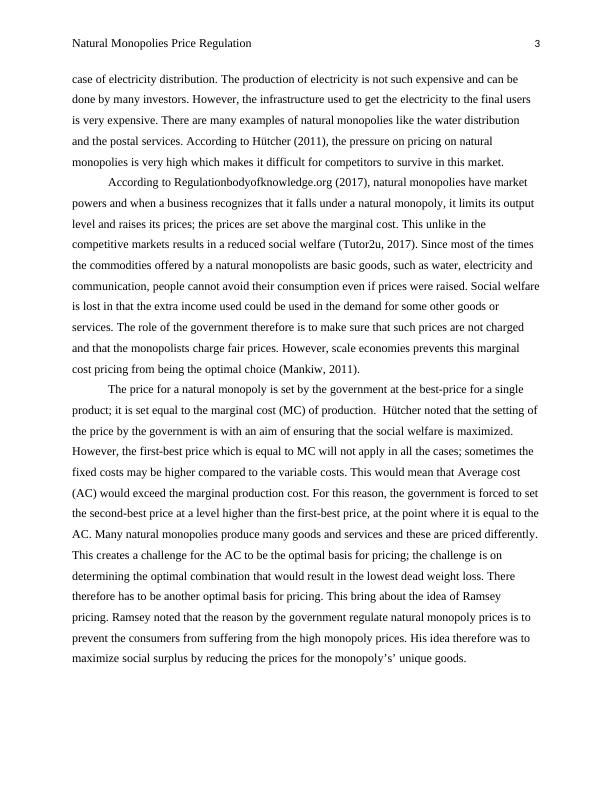Natural Monopolies Price Regulation
9 Pages2451 Words48 Views
Added on 2020-03-01
Natural Monopolies Price Regulation
Added on 2020-03-01
ShareRelated Documents
Running Head: Natural Monopolies Price RegulationGovernments Intervention on Natural Monopoly PricingStudent NameInstitutional AffiliationCourse/NumberInstructor NameDue Date

Natural Monopolies Price Regulation2Governments Intervention on Natural Monopoly PricingIntroductionThere are different types of market structures; perfect competition, monopolistic competition, oligopolies and monopoly markets. It is argued by most economists that competition is present in the perfect competitive markets because the number of sellers are many, small in size and price takers. However, when we consider the case for monopolies, this isa market whose supplier is a sole supplier who is large in size. There is no competition in the monopoly markets and the sole supplier is the price maker. The government is always against thepresence of oligopoly and monopoly markets since they are inefficient in price and outputs. The role is promoting competition in an economy by the government is achieved through monopoly pricing regulation.Being driven by the objective of maximizing profits, monopoly markets produced less output than would be for a competitive case and then sell this at a high price. The goods produced by the monopolies allow for the higher price charges since there are no close substitutes; the consumers have no other option than to accept the price offered no matter how high it becomes (Textbook Equity Edition, 2014). The natural monopoly is a special kind of monopoly existing due to the presence of high startup costs and fixed costs. Hillman (2007) noted that all pure public goods fall under a natural monopoly and it shall be seen on the analysisthat its more efficient to supply pure public goods through a natural monopoly than by duplication (Economicsonline.co.uk (2017). There are two important theories that explains price regulation for a natural monopolist. These are the Average cost pricing and the marginal cost pricing (Greer, 2012). The first one is the pricing made on the basis of average cost while the other one is the pricing made on the basis of marginal cost whether regulated or unregulated. It isexpected that the natural monopolies should be maintained in the economy for some goods to be provided at a lower price.Analysis A pure public good like water is best supplied by the natural monopoly because the production costs associated to the supply falls as the number of users increase. These natural monopolies have increased economies of scale (Linfo.org, 2006). Duplication would lower the economies of scale and the competitors would fight for prices which would make the prices charged to be higher (Textbook Equity Edition, 2014). Natural monopolies are present in the

Natural Monopolies Price Regulation3case of electricity distribution. The production of electricity is not such expensive and can be done by many investors. However, the infrastructure used to get the electricity to the final users is very expensive. There are many examples of natural monopolies like the water distribution and the postal services. According to Hütcher (2011), the pressure on pricing on natural monopolies is very high which makes it difficult for competitors to survive in this market. According to Regulationbodyofknowledge.org (2017), natural monopolies have market powers and when a business recognizes that it falls under a natural monopoly, it limits its output level and raises its prices; the prices are set above the marginal cost. This unlike in the competitive markets results in a reduced social welfare (Tutor2u, 2017). Since most of the times the commodities offered by a natural monopolists are basic goods, such as water, electricity and communication, people cannot avoid their consumption even if prices were raised. Social welfareis lost in that the extra income used could be used in the demand for some other goods or services. The role of the government therefore is to make sure that such prices are not charged and that the monopolists charge fair prices. However, scale economies prevents this marginal cost pricing from being the optimal choice (Mankiw, 2011).The price for a natural monopoly is set by the government at the best-price for a single product; it is set equal to the marginal cost (MC) of production. Hütcher noted that the setting ofthe price by the government is with an aim of ensuring that the social welfare is maximized. However, the first-best price which is equal to MC will not apply in all the cases; sometimes the fixed costs may be higher compared to the variable costs. This would mean that Average cost (AC) would exceed the marginal production cost. For this reason, the government is forced to setthe second-best price at a level higher than the first-best price, at the point where it is equal to theAC. Many natural monopolies produce many goods and services and these are priced differently.This creates a challenge for the AC to be the optimal basis for pricing; the challenge is on determining the optimal combination that would result in the lowest dead weight loss. There therefore has to be another optimal basis for pricing. This bring about the idea of Ramsey pricing. Ramsey noted that the reason by the government regulate natural monopoly prices is to prevent the consumers from suffering from the high monopoly prices. His idea therefore was to maximize social surplus by reducing the prices for the monopoly’s’ unique goods.

End of preview
Want to access all the pages? Upload your documents or become a member.
Related Documents
Monopoly and Monopolistic Competition in Australialg...
|8
|1997
|169
Monopoly Market Assignment Projectlg...
|11
|2776
|58
ECO511 - Economics for Business || Assignmentlg...
|12
|2771
|136
Monopoly and Monopolistic Competition in Australian Marketlg...
|11
|3186
|150
Market Structures and Barriers to Entry in Economicslg...
|6
|914
|443
HI 5003-Economics| Natural Monopolylg...
|8
|2239
|51
